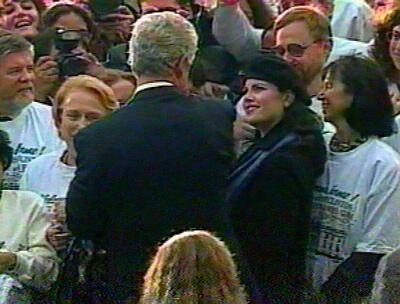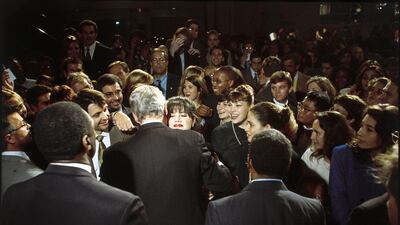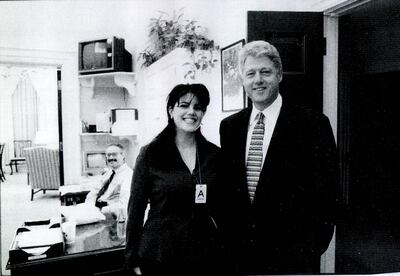How old were you when the news broke in January 1998 about the affair between Bill Clinton and Monica Lewinsky? It might seem like a trivial question, but it is one that matters very much to Leon Neyfakh, who has made an eight-part podcast about the affair and the series of events that culminated in the impeachment of the President of the United States.
In a recent essay introducing the second series of the Slow Burn podcast (the first focused on the Watergate scandal), Neyfakh writes: "It seems obvious now that Clinton's behaviour was wrong and indefensible, and it seems like it should've been obvious to everyone back then." He adds: "But even people who were fully sentient during the impeachment saga – I was in eighth grade – tend to have only hazy memories of how the whole thing played out."
For many of us, those hazy memories have calcified into a deep misunderstanding of a scandal that very nearly brought down the president. We are no doubt vaguely aware of some of the more salacious details, but it is harder, more than two decades after the event, to really get a grasp of what happened and why.
Of particular interest to Neyfakh, who interviewed dozens of people close to the case for the podcast, is how so many concluded that Lewinsky was the villain. “Are we more enlightened now?” he asks in the opening episode. “Or is there something we’re not appreciating about what it was like to live through the story in real time?”
The first episode begins on January 16, 1998. Lewinsky, who worked at the White House from 1995 to 1996, has just come from the gym and is waiting to meet her friend, confidante and former White House colleague, Linda Tripp, for lunch at a shopping mall in Pentagon City, Virginia. Suddenly, she is approached by a group of men from the FBI, who, it quickly transpires, have been tipped off by Tripp about Lewinsky’s affair with Clinton.

Lewinsky, who is only 24 years old, is whisked off to a nearby hotel room where she is held for 11 hours and informed that she faces up to 27 years in jail for lying on an affidavit about her relationship with Clinton – unless, of course, she agrees to co-operate with the independent counsel, Kenneth Starr, who has been investigating Clinton for more than three years.
“Monica Lewinsky had a choice to make,” says Neyfakh. “Should she co-operate with the Starr investigation or remain loyal to the president and risk a decades-long prison sentence?”
Lewinsky refused to bow to the demands, which included wearing a wire to record telephone conversations with Clinton and those close to him. This is often overlooked. "That is where she comes through, as I can't imagine anyone else would," says journalist Renata Adler at the conclusion of episode one. "I think there's an honesty, perhaps, underneath everything else, in the way Monica Lewinsky presents herself." The same could never be said of Clinton, who later denied the affair, dismissing Lewinsky as "that woman".
After the high drama of this opening, in the next two episodes (only three have been released so far), Neyfakh traces the story right back to the beginning of Clinton’s political career. He explores his troubled presidential campaign in 1992, which was dogged by sleaze and scandal. Clinton was forced to confront numerous other allegations of adultery and underwent an investigation into his property dealings, which came to be known as the “Whitewater controversy”.
_____________________
Read more
Podcasts: The week's essential top 10
Six food podcasts to satiate, entertain and educate
_____________________
Meanwhile, Clinton’s first term in office was defined by the suicide of an old friend from Arkansas, Vince Foster, who had joined Clinton as a deputy White House counsel. Foster became associated with a major scandal – the “White House travel office controversy” – when a number of staff at the travel office were dismissed without warning. This, critics claimed, allowed Clinton to surround himself with friends and cronies. “Here [in Washington], ruining people is considered sport,” Foster said.
It is to Neyfakh’s great credit that this often knotty, political build-up to the exposure of the Lewinsky affair remains so compelling. He is a fine narrator with a diligent eye for detail – Clinton’s nickname was “Slick Willy”; he could apparently eat a roast potato in two bites – who has managed to coax colourful contributions from a richly varied cast of characters.
Some of the most outrageous of these concern Paula Jones, a former Arkansas state employee, who filed a sexual harassment lawsuit against Clinton prior to his impeachment. "She didn't look like someone you'd find at a Washington cocktail party, she looked like the kind of woman that fancy Washington types looked down on," says Stuart Taylor, a journalist who, in 1997, wrote a 15,000-word article about Jones for American Lawyer magazine. "The image settled on her being kind of low class."
By providing us with so much of this background, Neyfakh leaves us in no doubt that Clinton and his administration were in free-fall, lurching from one disaster to the next, long before anyone had even heard of Monica Lewinsky. "They just kept on being their own worst enemies and their actual worst enemies were more than happy to take their missteps and exploit them," says Ruth Marcus, a journalist who reported on the White House for the Washington Post.
So why has Lewinsky’s name become synonymous with all that was wrong about Clinton’s time as President? We were all too willing, it seems, to pin his myriad failings on a 24-year-old woman. Clinton, remember, was acquitted on all charges and continued in the White House until 2001. Lewinsky’s life was never the same again.
Powerful men abusing their position. Young women being discarded as little more than collateral damage. In the shadow of the recent #MeToo movement, the Monica Lewinsky story feels more prescient than ever.
Slow Burn series two is available at www.slate.com




